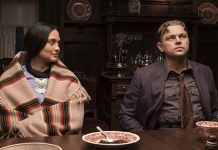(Welcome to The Quarantine Stream, a new series where the /Film team shares what they’ve been watching while social distancing during the COVID-19 pandemic.)
The Movie: American Graffiti
The Pitch: American Graffiti is a classic coming-of-age story set against the 1960s backdrop of hot rods, drive-ins and rock n’ roll. Set in Modesto, California, the film follows an ensemble of students enjoying their final night as high school seniors before they each go their separate ways and begin their journey down the path of adulthood.
Why It’s Essential Viewing: George Lucas is best known for creating the groundbreaking Star Wars, as well as the exciting adventures of Indiana Jones. But before becoming a blockbuster filmmaker, Lucas was just a young gun trying to tell stories that appealed to his age group: adults in their late 20s and early 30s who were still trying to hold onto the nostalgia of their teenage years in the 1960s. Perhaps Lucas’ most grounded and honest filmmaking effort came when he tried to recapture young life as it was in 1962 with American Graffiti. Even though the movie is was financed by Universal, Lucas maintained complete control over the movie, resulting in what is ultimately a coming-of-age indie that wouldn’t feel out of place at the Sundance Film Festival.
Roger Ebert wrote in his review of the movie, “American Graffiti is not only a great movie but a brilliant work of historical fiction; no sociological treatise could duplicate the movie’s success in remembering exactly how it was to be alive at that cultural instant.” But that movie also captured, perhaps inadvertently, what it was like to live in a small Midwestern town in any given decade that would follow. American Graffiti isn’t just a portrait into the life of teens in 1962, but also a timeless glimpse into the life of kids who don’t have anything better to do than cruise up and down the main strip of road in town, parking at nearby shops, passing time as time passes them by. How do I know this? I lived it for four years.
The characters played by Richard Dreyfuss, Ron Howard, Paul Le Mat, Harrison Ford, Charles Martin Smith, Cindy Williams, Candy Clark, Mackenzie Phillips, and Bo Hopkins all feel like people I knew in high school, and that was in the early 2000s. These archetypes can be found in every high school to this day, and in every generation before and since 1962, just with some minor aesthetic and timely differences. Not only did I see them in high school, I’m undoubtedly a composite of a couple of them.
Though the cars and clothes have certainly changed, the attitudes of the kids haven’t. In the small Northwest Indiana town where I grew up, there were kids desperate to get out by going to college far away. There were couples equally as desperate to hold onto their young love despite having the whole world in front of them. And there were kids who would end up content with becoming the townies that they never wanted to be. All of these characters ring true to my life in a small town, and it makes the movie that much more relatable and dear to my heart.
Though Lucas’ movie seems to be relying on nostalgia, the ending of the movie pulls the rug out from under us by reminding everyone that the good times are gone and all the kids who grew up in 1962 went on to have adult lives, some much more short-lived than others, and some never living up to their full potential. It’s a sobering reminder that no matter how good the past was, and no matter how much comfort it brings us in the present, we can’t forget that there’s still the whole future ahead of us. If we keep glancing longingly at the good old days, we won’t have any new days to cherish.










![Joe Pantoliano on Working With Tom Cruise, Being Directed by Steven Spielberg, and More [Interview]](https://artnewspress.com/en/wp-content/uploads/2020/01/photo_2020-01-07_18-45-29-100x70.jpg)












